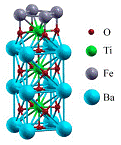Department of Physics and Astronomy: Publications and Other Research

Evgeny Tsymbal Publications
ORCID IDs
Tsymbal http://orcid.org/0000-0002-6728-5550
Document Type
Article
Date of this Version
2016
Citation
Physical Rreview Letters (2016) 116: 197602
Abstract
Realizing a large tunneling electroresistance (TER) effect is crucial for device application of ferroelectric tunnel junctions (FTJs). FTJs are typically composed of a thin ferroelectric layer sandwiched by two metallic electrodes, where TER generally results from the dependence of the effective tunneling barrier height on the ferroelectric polarization. Since the resistance depends exponentially not only on barrier height but also on barrier width, TER is expected to be greatly enhanced when one of the electrodes is a semiconductor where the depletion region near the interface can be controlled via ferroelectric polarization. To explore this possibility, we perform studies of SrRuO3/BaTiO3/n − SrTiO3 FTJs, where n-SrTiO3 is an electron doped SrTiO3 electrode, using first-principles density functional theory. Our studies reveal that, in addition to modulation of the depletion region in n-SrTiO3, the BaTiO3 barrier layer becomes conducting near the interface for polarization pointing into n-SrTiO3, leading to dramatic enhancement of TER. The effect is controlled by the band alignment between the semiconductor and the ferroelectric insulator and opens the way for experimental realization of enhanced TER in FTJs through the choice of a semiconducting electrode and interface engineering.


Comments
Copyright © 2016, American Physical Society. Used by permission